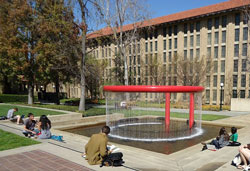A Stanford University study finds acupuncture safe and cost-effective for relieving pain in children. Dr. Golianu, MD (Department of Anesthesiology, Stanford University), et. al., note research confirming that acupuncture is “useful in chronic pain conditions” adding that it may be clinically valuable in an integrative medical setting.  The research documents acupuncture’s ability to stimulate natural pain killers within the body, dynorphins and endorphins, along with several other important biological responses involved in pain management. The researchers cited multiple findings of acupuncture successfully relieving headaches, migraines, abdominal pain, fibromyalgia, pelvic pain, Complex Regional Pain Syndrome (CRPS), acute post-operative pain, and post-operative delirium.
The research documents acupuncture’s ability to stimulate natural pain killers within the body, dynorphins and endorphins, along with several other important biological responses involved in pain management. The researchers cited multiple findings of acupuncture successfully relieving headaches, migraines, abdominal pain, fibromyalgia, pelvic pain, Complex Regional Pain Syndrome (CRPS), acute post-operative pain, and post-operative delirium.
Children Accept Acupuncture
The Stanford University research team cites findings that “53% of children were initially apprehensive of acupuncture needles, following their first needle 64% felt it did not hurt, and furthermore would recommend it to someone else.” In adolescents, 67% report acupuncture as “pleasant” and 70% report that acupuncture reduced pain levels. The receptivity to acupuncture may be due, in part, to acupuncture’s ability to induce deep relaxation in patients combined with lasting analgesic effects.
The researchers note that, “Acupuncture can be a useful adjuvant in the care of pediatric patients with painful conditions, both in the chronic and acute setting.” Citing Lin, et. al., young children and adolescents experienced significant pain relief from acupuncture treatments. The children also found acupuncture “highly acceptable.” On safety, the research confirms “that acupuncture is safe when performed by appropriately trained practitioners.” In the United States, acupuncturists are licensed medical professionals with medical board oversight in most states.
Headaches
The researchers note that acupuncture decreases headache frequency and severity across several controlled studies. In addition, acupuncture reduces the need for medications and is proven effective in treating migraines. The research team cites a randomized trial of children with migraines finding acupuncture effective in reducing the intensity and frequency of migraines. Another pediatric study meeting the review standards of the research team finds cold laser acupuncture effective for reducing the frequency of migraines and tension headaches.
Abdominal Pain
The researchers cited findings showing acupuncture in adults effective for treating IBS, irritable bowel syndrome, “a comparative effectiveness trial of acupuncture compared to two antispasmodics (pinaverium bromide and trimebutin maleate) showed acupuncture as more effective than these standard therapies for IBS.” A pediatric study found acupuncture effective for the treatment of intermittent abdominal pain. Given the prevalence of abdominal pain in children, the researchers recommend further studies investigating the “dose or frequency and duration of acupuncture treatment required.”
Fibromyalgia and Arthritis
The research team did not find randomized controlled pediatric studies on the treatment of fibromyalgia. However, adult studies find acupuncture “superior to standard care alone.” In addition, “Acupuncture was found to change cortical responses to painful stimuli in fibromyalgia patients, suggesting a complex inhibitory modulation may be active in the central nervous system in fibromyalgia patients.” The same scenario was found in the case of juvenile arthritis. No pediatric studies have been conducted but adult studies find acupuncture effective for the treatment of osteoarthritis. For fibromyalgia and arthritis, the research team recommends specific investigations on the effects of acupuncture on children.
Pelvic Pain
Pediatric studies have been conducted on the effectiveness of acupuncture. A study of adolescents with dysmenorrhea (menstrual cramping and pain) finds acupuncture equally as effective as NSAIDS, non-steroidal anti-inflammatory drugs. Another study of pelvic pain caused by endometriosis finds acupuncture effective in reducing pain with residual results documented at six months following the treatment regime. 
CRPS, Cancer and Acute Pain
Both adult studies and a pediatric study demonstrated acupuncture’s clinical efficacy for the treatment of Complex Regional Pain Syndrome (CRPS). Researchers found that 29% of young children and 36% of adolescents with cancer in Germany use acupuncture. The researchers found quality studies showing acupuncture effective for reducing nausea and vomiting related to cancer chemotherapy treatments along with a reduced need for anti-emetic medications. The researchers note that a study of children from ages 7 months to 18 years experienced significant and lasting post-operative pain relief from acupuncture. Other pediatric studies find acupuncture effective in reducing post-operative delirium, pain and agitation.
Cost-Effectiveness
The research team looked into a cost-benefit analysis of acupuncture. A study was conducted by Great Britain’s National Health Service (NHS) on patient’s with lower back pain. The randomized investigation revealed that “the addition of acupuncture to standard care led to improved pain both immediately after the treatments as well as at 24 months. Though the cost of delivering acupuncture in addition to standard care was an increase of expenditure, this cost was more than balanced by a reduction in lost days of work, and decreased medical spending in other areas including hospitalization, general practitioner or other outpatient visits.”
Based on the review of available quality research including large sample randomized-controlled studies, the researchers note that acupuncture “can be an important adjuvant in the care of the pediatric patient with chronic pain.” They add, “The evidence suggests that it is a safe and cost-effective treatment modality for pediatric pain.”
References:
Golianu, Brenda, Ann Ming Yeh, and Meredith Brooks. "Acupuncture for Pediatric Pain." Children 1, no. 2 (2014): 134-148. Author Affiliations:
Department of Anesthesiology and Pain Medicine, Pediatric Anesthesiology, Stanford University, Stanford, California.
Pediatric Gastroenterology, Stanford University, Palo Alto, California.


